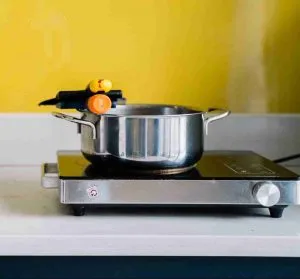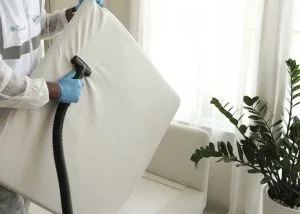Contents
ToggleThe Difference Between Cooling and Dehumidifying
To fully comprehend the distinctions between cooling and dehumidifying, it’s essential to know the primary goals and functions of air conditioners and dehumidifiers. While both appliances are designed to improve indoor comfort and air quality, they achieve this through different mechanisms and with different end results. Let’s dive deeper into what sets cooling and dehumidifying apart.
Cooling: The Role of Air Conditioners
Air conditioners are specifically designed to lower the temperature of the air in a room. They achieve this by using a refrigeration cycle that involves removing heat and humidity from the air. The air conditioner pulls in warm air from the room, which then passes over cold evaporator coils containing refrigerant. This process cools the air and removes moisture, resulting in a more comfortable and less humid environment.
Once the heat and humidity have been extracted, the cooled air is blown back into the room, while the heat is released outside through the condenser coils. The end result is a room with a lower temperature and reduced humidity, which makes the space more comfortable for occupants.
Dehumidifying: The Purpose of Dehumidifiers
On the other hand, dehumidifiers focus primarily on removing moisture from the air, rather than cooling it. As we saw in the previous section, a dehumidifier works by drawing in moist air, cooling it to condense the moisture, and then reheating the air before releasing it back into the room.
While this process may bear similarities to an air conditioner’s operation, the main difference lies in the fact that a dehumidifier does not actively cool the air. Instead, its primary objective is to reduce humidity levels, which can contribute to a more comfortable environment and help prevent issues like mold growth and allergen accumulation. However, since the air is reheated before being released, a dehumidifier can actually make a room feel slightly warmer, rather than cooler.
In summary, air conditioners and dehumidifiers serve distinct purposes in managing indoor comfort. While air conditioners are designed to both cool the air and reduce humidity, dehumidifiers focus solely on removing moisture from the air. Understanding these differences is crucial when choosing the right appliance for your specific needs and maintaining a comfortable living space.
How a Dehumidifier Works
A dehumidifier is a sophisticated appliance that operates by extracting moisture from the air in a room, making the environment more comfortable and reducing the risk of mold and mildew growth. The process is more complex than it may seem at first glance, and although it shares some similarities with air conditioners, there are key differences between the two. Let’s take a closer look at how a dehumidifier works.
Step 1: Drawing in Moist Air
A dehumidifier begins its operation by pulling in moist air from the room through an intake vent. This is achieved using a built-in fan, which helps circulate the air and ensures a continuous flow of damp air into the unit.
Step 2: Cooling the Air and Condensing Moisture
Once the moist air is drawn into the dehumidifier, it passes over a set of cold coils, known as the evaporator coils. These coils are cooled by the refrigerant, which is circulated through them by a compressor. As the moist air comes into contact with the cold coils, the temperature of the air drops, causing the moisture in the air to condense into water droplets.
Step 3: Collecting the Condensed Water
The water droplets formed during the condensation process then drip down into a collection bucket or tray, which is located within the dehumidifier. Some models may also have a direct drain option, allowing the water to be continuously drained through a hose and eliminating the need for manual emptying.
Step 4: Reheating and Releasing Dry Air
After the moisture has been removed from the air, it is passed over another set of coils called the condenser coils. These coils are heated by the same refrigerant that was used to cool the evaporator coils, which in turn warms the air. This reheating process is important because it prevents the dehumidifier from making the room feel too cold. The now dry and slightly warmer air is then blown back into the room through an exhaust vent, resulting in a more comfortable living environment.
While this process might appear similar to how an air conditioner works, there is a crucial distinction: a dehumidifier does not actively cool the air. In fact, because the air is reheated before being released, a dehumidifier can actually make a room feel a bit warmer. However, the primary objective of a dehumidifier is to reduce humidity, which can still provide significant benefits in terms of comfort and air quality.
The Impact of Humidity on Temperature
The impact of humidity on temperature perception is a critical aspect of indoor comfort, and understanding this relationship can help homeowners create a more pleasant living environment. High humidity can greatly affect how we perceive the temperature in a room, making it feel much warmer and less comfortable than it actually is. Let’s explore the reasons behind this and how a dehumidifier can help improve comfort levels.
The Role of Humidity in Temperature Perception
Humidity refers to the amount of moisture present in the air. When humidity levels are high, the air contains more water vapor, which can interfere with our body’s natural cooling mechanism – the evaporation of sweat. As we perspire, the moisture on our skin evaporates into the air, carrying heat away from our bodies and helping us maintain a comfortable body temperature.
However, when the air is already saturated with moisture, the evaporation process becomes less efficient, and our bodies struggle to release heat. As a result, we perceive the environment to be warmer and more uncomfortable than it would be under lower humidity conditions.
How Dehumidifiers Improve Comfort Levels
Dehumidifiers can play a crucial role in mitigating the discomfort caused by high humidity. By extracting excess moisture from the air, dehumidifiers help maintain an optimal indoor humidity level, which, as mentioned in the article about Basement Humidity, should ideally be between 30% and 50%.
By lowering humidity levels within this range, a dehumidifier can significantly improve the indoor environment, making it feel more comfortable and less muggy. This enhanced comfort is achieved without actually changing the room’s temperature, but rather by facilitating the body’s natural cooling mechanism through more efficient sweat evaporation.
Moreover, maintaining optimal humidity levels can help prevent various issues associated with high moisture levels, such as mold and mildew growth, damage to furniture and electronics, and the proliferation of allergens like dust mites.
The Limitations of a Dehumidifier
While dehumidifiers are valuable appliances for improving indoor comfort and air quality, it’s important to recognize their limitations. Primarily designed to remove moisture from the air, dehumidifiers are not intended to cool a room. Understanding these constraints will help you make informed decisions about which appliance is best suited for your needs and avoid unrealistic expectations.
Dehumidifiers Aren’t Cooling Solutions
As we’ve discussed, a dehumidifier’s primary objective is to reduce humidity levels in a room. Although this can contribute to a more comfortable living environment, it does not actively lower the air temperature. In fact, since dehumidifiers reheat the air before releasing it back into the room, they can sometimes make the space feel slightly warmer.
If your main goal is to cool your room, an air conditioner would be a more appropriate solution. Air conditioners are specifically designed to lower the temperature by removing heat and humidity from the air, providing more effective cooling than a dehumidifier can offer.
Dehumidifiers Aren’t a Fix for Icing Problems
Another limitation of dehumidifiers is their inability to address certain issues related to frost and ice formation. While a dehumidifier can help prevent ice from forming on your air conditioner’s coils by reducing humidity levels, it will not resolve the problem if your dehumidifier itself is experiencing icing issues.
If your dehumidifier is icing up, as described in Dehumidifier Icing Up, you will need to address the root cause of the problem. This could include factors such as poor airflow, low refrigerant levels, or operating the dehumidifier in temperatures below its recommended range. In these cases, it’s essential to consult your dehumidifier’s manual or contact a professional for assistance in diagnosing and resolving the issue.
The Benefits of Using a Dehumidifier
Even though a dehumidifier won’t cool your room, there are still plenty of benefits to using one. For starters, it can help reduce the growth of mold and mildew, as these organisms thrive in damp environments. By maintaining a lower humidity level, you can keep mold and mildew at bay, which is especially important in areas like bathrooms where moisture tends to accumulate. For more information on dealing with mold, check out this article on how to get rid of mold in a bathroom.
In addition to preventing mold and mildew growth, a dehumidifier can improve indoor air quality by reducing allergens like dust mites, which also thrive in humid environments. This can be particularly beneficial for allergy sufferers, as it can help alleviate symptoms like sneezing, itching, and watery eyes.
Another advantage of using a dehumidifier is its potential to reduce energy costs. When humidity levels are high, your air conditioner has to work harder to cool the room, which can result in higher energy consumption. By lowering the humidity, a dehumidifier can help your air conditioner work more efficiently, which can ultimately save you money on your energy bills.
To make the most of your dehumidifier, be sure to check out the top dehumidifiers on the market and learn more about the water produced by dehumidifiers.
Tips for Using a Dehumidifier
To maximize the benefits of your dehumidifier, follow these tips:
- Set the appropriate humidity level: Aim for a humidity level between 30% and 50% as this will help maintain a comfortable indoor environment while preventing mold and mildew growth.
- Place the dehumidifier in the right location: Position your dehumidifier in the area where humidity is the highest, such as a basement or bathroom. Make sure it’s placed away from walls, furniture, and curtains to ensure proper airflow.
- Clean the unit regularly: Regular maintenance is essential for keeping your dehumidifier running efficiently. Clean the air filter, empty the water collection bucket, and check for any signs of wear and tear. For more information on when to use a dehumidifier and how to maintain it, visit this guide.
Alternatives to Using a Dehumidifier
If you’re looking for ways to cool your room in addition to using a dehumidifier, consider the following alternatives:
- Air conditioner: An air conditioner is specifically designed to cool a room by removing both heat and humidity. This is the most effective way to lower the temperature in your space.
- Ceiling fan: While a ceiling fan doesn’t actually cool the air, it can create a wind-chill effect that makes a room feel cooler. This can be a cost-effective and energy-efficient alternative to using an air conditioner.
- Portable fan: Similar to a ceiling fan, a portable fan can help circulate the air in a room, making it feel cooler. Check out the top tower fans for some great options.
 | Portable Air Conditioner Fan Wavego 1400ml | CHECK PRICE |
 | Pro Breeze Smart Air Conditioner Portable 10,000 BTU - 1130W | CHECK PRICE |
 | Dreo Nomad One Tower Fan with Remote | CHECK PRICE |
 | Lasko Oscillating High Velocity Tower Fan | CHECK PRICE |
 | BOJUE 52” Ceiling Fans with Lights Remote Control | CHECK PRICE |
 | Orison Low Profile Ceiling Fan with Lights | CHECK PRICE |
 | Prominence Home Light Hugger/Low Profile Ceiling Fan | CHECK PRICE |
FAQ:
How much cooler does a dehumidifier make a room?
A dehumidifier does not actively cool a room; its primary function is to remove moisture from the air. While it can make a room feel more comfortable by reducing humidity levels, it does not lower the temperature. In fact, the reheating process during dehumidification may make the room feel slightly warmer.
Are dehumidifiers good for hot weather?
Dehumidifiers can be beneficial in hot weather if high humidity levels are causing discomfort. By removing excess moisture from the air, they can help make the room feel more comfortable, but they will not lower the temperature. For cooling purposes, consider using an air conditioner instead.
Does a dehumidifier make a room hotter or colder?
A dehumidifier typically makes a room feel slightly warmer, as it reheats the air after removing moisture. While it can improve comfort by reducing humidity levels, it does not actively cool the air. If you need to lower the temperature in your room, an air conditioner would be more suitable.
Can you use a dehumidifier as an air conditioner?
No, a dehumidifier cannot be used as an air conditioner. While both appliances remove moisture from the air, a dehumidifier is not designed to cool a room. An air conditioner is specifically engineered to lower the temperature, making it the better option for cooling purposes.
Do I need both a dehumidifier and an air conditioner?
Whether you need both a dehumidifier and an air conditioner depends on your specific needs. If your primary concern is high humidity levels and you want to maintain a comfortable environment, a dehumidifier may be sufficient. However, if you need to cool your room and lower the temperature, an air conditioner would be more appropriate. Some people may benefit from using both appliances to effectively manage both temperature and humidity.
Will a dehumidifier help reduce energy costs?
A dehumidifier can help reduce energy costs indirectly by maintaining optimal humidity levels in your home. This can improve the efficiency of your air conditioner, as it will not have to work as hard to remove excess moisture while cooling the room. As a result, your air conditioner will consume less energy, leading to potential cost savings.
How often should I clean my dehumidifier?
Regular maintenance is essential for keeping your dehumidifier functioning efficiently. It is recommended to check and clean the air filter every 30 days, or according to the manufacturer’s instructions. Additionally, empty and clean the water collection bucket as needed to prevent the growth of mold and bacteria.
Can I use a fan instead of a dehumidifier to improve comfort?
A fan can provide some relief from heat and humidity by increasing air circulation in a room, but it does not actively remove moisture from the air like a dehumidifier. Using a fan in combination with an air conditioner or dehumidifier can further improve comfort levels by distributing cooled or dehumidified air more effectively throughout the room.
Wrapping It Up
In conclusion, while a dehumidifier won’t actively cool a room, it can help make the space feel more comfortable by reducing humidity levels. This, in turn, can prevent mold and mildew growth, improve indoor air quality, and even lower your energy costs. If you’re looking for an appliance to cool your room, however, you’ll need to invest in an air conditioner or consider using fans to create a more comfortable environment.
By understanding the differences between cooling and dehumidifying, as well as the benefits and limitations of a dehumidifier, you can make an informed decision about the best way to maintain a comfortable temperature in your home during those hot summer months.























































